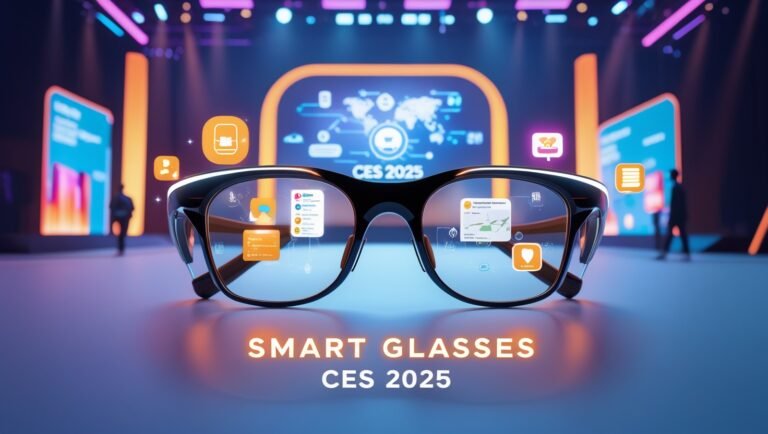Remember the days when futuristic tech seemed like something only Hollywood could dream up? Well, reality has officially caught up. The smart glasses era is here, and after getting an exclusive first look, I can confidently say: these might just be the most exciting gadgets of our time. Let’s explore where this tech is going, what sets it apart, and why your next favorite device could be hanging right on your face.
What Are Smart Glasses Anyway?
Smart glasses are wearable tech designed to do more than just help you see—they enhance your reality. From projecting digital overlays into your vision to integrating voice controls, GPS, and even cameras, they combine style with substance. Think of them as the lovechild of your smartphone and your sunglasses.
At CES 2025, smart glasses took center stage, cementing themselves as the trend to watch this year. Companies like Rokid, Vuzix, and Xreal showcased their latest innovations side by side with newcomers like Nuance Audio, raising the bar for functionality and design. Read more about what we learned from CES.
What’s So Special About These Glasses?
1. Augmented Reality is No Longer Science Fiction
Smart glasses now feature integrated AR technology that creates a virtual overlay on real-world views. Want to follow navigation directions that appear like arrows on the road in front of you? Done. Need subtitles for your meeting with a global client? Also done. With the Xreal Air 2 or Halliday Vision, it’s like having a pocket-sized Tony Stark AI.
2. Upgraded Audio-tech
One surprising takeaway? Nuance Audio Glasses, with open-ear sound that doesn’t compromise your ability to stay aware of your environment. These glasses use bone-conduction tech—goodbye, earbuds!

3. Lightweight Meets Fashion
Gone are the bulky frames that scream “tech gadget.” Companies like Ray-Ban, with their chic collaboration with Meta, and startups like Rokid, have nailed the blend of aesthetics and functionality. Fashionistas, rejoice! Finally, wearable tech you’ll actually want to wear.
A Deep Dive: How Do They Work?
Before you’re convinced to trade in your trusty sunglasses, let’s break it down:
| Feature | How It Works | Use-Cases |
|---|---|---|
| Display Technology | Built-in micro projectors display visuals directly on lenses | Navigation, gaming, AR sports stats |
| Camera Integration | Front & side cameras capture your POV | Hands-free photography, remote work |
| AI Voice Support | Virtual assistants integrated for voice commands | Siri, Alexa, or your preferred AI bot |
| Connectivity | Bluetooth/Wi-Fi sync to phones, tablets, or smart homes | Calls, music, and streaming Netflix |
This isn’t just wearable tech; it’s wearable productivity.
FAQs About Smart Glasses
1. Are smart glasses better than VR headsets?
Great question. Smart glasses aim for lightweight, everyday use instead of full immersion like VR headsets. They excel in scenarios like navigating cities, reading emails, or enhancing your Netflix marathon.
2. Can I use smart glasses for prescription lenses?
Yes! Companies like Vuzix are already integrating prescription lenses, making them practical for those who already rely on glasses.
3. Are smart glasses affordable?
Not yet “cheap,” but prices are becoming more consumer-friendly. Ray-Ban’s collaboration, for example, starts at $299, while Apple’s upcoming glasses (rumored at $499) could be a game-changer.
4. Can they replace my smartphone?
While they’re edging in, they’re not quite a complete replacement—yet. Expect to use them alongside your phone for now.
The Future of Smart Glasses: Why This is Just the Beginning
There’s no denying we’re at the cusp of something major. Analysts predict the smart glasses market will reach $24 billion by 2030, with applications spanning healthcare, retail, gaming, and beyond. Emerging startups and tech giants alike are investing heavily in AR advancements, giving us a glimpse of where this industry might go.
Fun fact: Did you know Apple’s rumored launch of their first-gen glasses could include LiDAR technology? Yep, that same advanced tech used in self-driving cars might soon sit on your nose.
Grandview Research confirms the industry’s buzz and growing versatility, from remote surgeries to immersive learning environments. The possibilities? Endless.
What Makes Smart Glasses So Special in 2025?
At CES alone, I got to see vendors solve some of the biggest past pain points in the field:
- Battery life? Improved by up to 20 hours on a single charge.
- Bulky hardware? Say hello to sleeker, lightweight designs.
- Clunky interfaces? We now have seamless gesture and voice controls.
Remember when smartphones initially seemed like a “nice-to-have” instead of a necessity? That’s smart glasses today. They’re moving from a niche innovation toward becoming mainstream.
Are Smart Glasses for You?
Still sitting on the fence? Start by asking yourself these questions:
- Do you rely on multitasking?
- Do you embrace wearables in your day-to-day life?
- Do you like exploring cutting-edge technology?
If you nodded yes, it’s time to start your journey into the smart glasses revolution.
Hot Tip: If you’re unsure of which model to dive into, CES 2025’s lineup showcased great starter options—hand in hand with their jaw-dropping AR applications. Check out our detailed review for the full scoop.
Final Thoughts: Ready to Embrace the Future?
The smart glasses era is here, pulling us into a world where tech isn’t just useful—it’s intuitive, stylish, and downright cool. As I walked through CES 2025, holding demos, running hands-free video calls, and gawking at real-time translations, one thing became clear: this technology isn’t just hype. It’s happening.
So, are you ready to don a pair and live in a smarter, tech-forward world? I’d love to hear your thoughts—what excites you most about smart glasses, and which feature would you use every day? Drop a comment below and let’s talk tech! 🌟
(Pro Tip: Keep an eye on Apple’s and Vuzix’s launches later this year—big things are coming.)
FAQs
Q1: What are smart glasses?
A: Wearable tech that enhances your vision with digital overlays and AI.
Q2: How much do smart glasses cost?
A: Prices vary widely, from under $200 to over $1,500.
Q3: What can smart glasses do?
A: Navigation, translation, hands-free calling, AR gaming and more.
Q4: Will smart glasses replace phones?
A: Not yet, but they are becoming increasingly capable.
Q5: What companies make smart glasses?
A: Apple, Meta, Ray-Ban, Vuzix, Rokid, and many more.

